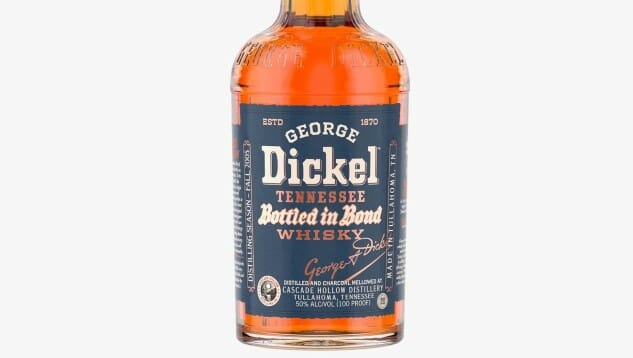
If you could go back in time 10-15 years to visit the whiskey aisle of your local package store, one of the first things you’d note (beyond the fact that you’d desperately want to acquire all the Pappy Van Winkle you could for modern resale) would be how our relationship with the words “bottled in bond” has changed in recent years.
A decade ago, you’d have found it difficult to find the words “bottled in bond” on anything that wasn’t on the bottom shelf, or near to it. That doesn’t speak necessarily to the quality of those whiskeys, but to the fact that the term itself had become something of a dinosaur—an archaic bit of whiskey terminology that was a holdover from an era when it was a more useful descriptor. It’s no surprise that the term was largely associated with older brands such as Rittenhouse Rye, Old Granddad or Very Old Barton—they were the only ones still using the words.
The term had arisen in the first place way back in 1897, as a guarantee of sorts of whiskey purity and quality. The “bottled in bond” designation implied a number of quality standards, from being the product of a single distillery, to being at least 4 years old and 100 proof. At that time, it meant products bearing the “bottled in bond” designation were premium whiskeys of their day. Over time, however, as large distilling corporations produced older and generally more refined and fancy flagship spirits, the “bottled in bond” designation eventually came to symbolize “value” more than anything else. In the 1990s or 2000s, if you visited a package store, the bottled in bond whiskeys available often held the distinction of offering some of the most bang for your buck. They were cheap, but dependable.
But then … the microdistillery/independent distillery revolution happened. As it was with craft beer, so it was again with whiskey, only this time it took rather longer for the little guys to catch up. You can’t exactly blame them, given that proper bourbon and rye take years to age. But when a young crop of microdistillers all started reaching maturity together, they discovered something: They could once again use the term “bottled in bond,” except now they could apply it as evidence that they were producing a special, more premium product. In a sense, it means we’ve come entirely full circle, and we’ve reviewed some really excellent, independently produced BiB bourbon and BiB rye in the last year. Once again, “BiB” is en vogue.
The major distilleries haven’t been sleeping on these developments, either. In fact, several of them are now toying around with the bottled in bond label, applying it to their own well-aged, premiumized products, seemingly in an effort to expand the cultural consciousness of what “bottled in bond” really means. There’s Heaven Hill, for instance, offering a 13-year-old expression of their wheated bourbon Old Fitzgerald, and selling it for a gaudy $130. Nevermind the fact that the whiskey only had to be 4 years old in order to have the words “bottled in bond” on it—this is indicative of old companies looking at old labels in a new way.
Not to be outdone is George Dickel, who are new on the scene with a fascinating development: George Dickel Bottled in Bond, a likewise 13-year-old Tennessee whiskey. The big, obvious difference here? Dickel is selling the contents of this bottle for a rather incredulous sounding $36. Yeah, you heard that right: $36 for a bottle of 13-year-old, 100 proof whiskey. Try finding that anywhere else on the modern whiskey market—it’s not going to happen. Not since Elijah Craig lost its 12 year age statement has such a value been close to possible, and Dickel’s is a full 100 proof to boot—and charcoal mellowed, like other Tennessee whiskeys.
Of course, this potential value has made us all the more curious to taste George Dickel Bottled in Bond, so let’s give it a go.
On the nose, this 13-year-old Dickel strikes me as a particularly nutty dram, with notes of peanut shells, almond candy, caramel, cinnamon and peanut butter-like sweetness. The peanut notes are a bit like the ones I typically experience with inexpensive Beam products such as Beam White Label or Old Crow, although nowhere near the same omnipresent intensity, which is a good thing.
On the palate, this whiskey is smooth of texture, and again features plenty of toasty/roasted nuttiness. Apricot fruitiness is also present, along with deep caramel, nutmeg spice, cinnamon candy and some light florals. The heat is fairly expressive, but it manifests in the form of a long, endearing “Kentucky hug” more than it does on the palate, which is quite pleasant if I do say so myself. There’s a persistent, oaky tenacity throughout as well, although not of the overly tannic or astringent variety, with a finish that hints at old, oiled leather.
Ultimately, one’s enjoyment of this particular dram probably boils down to your appreciation of that nuttier dimension to the flavor profile. If I’m being honest, that’s not a favorite profile of mine, but that’s a matter of personal taste more than anything. I still recognize George Dickel Bottled in Bond as a quality product, and at only $36 it’s an almost suspiciously great value for such a well-aged whiskey. This is certainly one of the lowest-risk purchases you’re going to make in the near future, and I wouldn’t be surprised to see the price rise substantially after its initial release.
Distillery: George Dickel (Diageo)
City: Cascade Hollow, TN
Style: Tennessee whiskey
ABV: 50% (100 proof)
Availability: 750 ml bottles ($36 MSRP)
Jim Vorel is a Paste staff writer and resident brown liquor geek. You can follow him on Twitter for more drink writing.